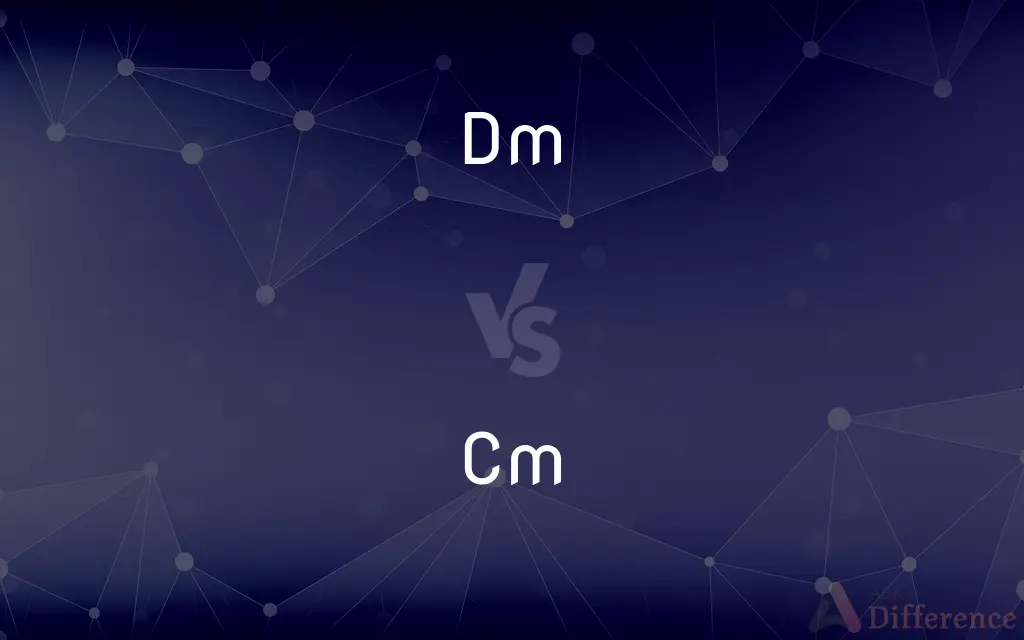Dm vs. Cm — What's the Difference?
Edited by Tayyaba Rehman — By Urooj Arif — Updated on April 8, 2024
A decimeter (dm) is a unit of length in the metric system, equal to one-tenth of a meter, while a centimeter (cm) is one-hundredth of a meter, making dm larger.

Difference Between Dm and Cm
Table of Contents
ADVERTISEMENT
Key Differences
A decimeter (dm) measures length in the metric system, representing one-tenth of a meter. It's used less frequently in daily measurements but is useful in scientific contexts for mid-sized objects. Whereas, a centimeter (cm) is a more commonly used unit for measuring length, equivalent to one-hundredth of a meter, ideal for small objects and detailed measurements.
Decimeters provide a middle ground between the meter and centimeter, useful for objects like textbooks or small household items. On the other hand, centimeters are preferred for precision, such as measuring the dimensions of a phone or the thickness of a book.
In scientific research and technical fields, decimeters can be useful for measurements that require a balance between granularity and scale. Meanwhile, centimeters are widespread in everyday use, from tailoring clothes to manufacturing parts where fine detail is crucial.
When converting to other metric units, a decimeter easily translates into 10 centimeters or 0.1 meters, showcasing its position in the metric hierarchy. Conversely, a centimeter is more directly relatable to millimeters, with 10 mm making up 1 cm, emphasizing its role in precise measurements.
In education, decimeters are sometimes introduced to help students grasp the concept of the metric system’s scalability. However, centimeters, being more tangible for measuring everyday objects, are more commonly taught and used from a young age.
ADVERTISEMENT
Comparison Chart
Definition
One-tenth of a meter
One-hundredth of a meter
Use in daily life
Less common, mid-sized objects
Common, small objects
Precision
Lower, for larger objects
Higher, for detailed measurements
Conversion
1 dm = 10 cm, 0.1 m
1 cm = 10 mm, 0.01 m
Educational use
Introduced for scalability
Widely taught and used
Compare with Definitions
Dm
Used to measure medium-sized objects.
The aquarium is 5 dm long.
Cm
Easily convertible to millimeters.
The thickness of the book is 2 cm.
Dm
Relates to the metric system’s base unit.
The box is 4 dm high.
Cm
A unit of length equal to one-hundredth of a meter.
The phone screen is 14 cm long.
Dm
A unit of length equal to one-tenth of a meter.
The width of the bookshelf is 8 dm.
Cm
Common in daily usage for small objects.
The notebook is 21 cm tall.
Dm
Serves as a bridge between meter and centimeter.
She measured the table’s length as 1.2 dm.
Cm
Taught extensively in schools.
The ruler has a length of 30 cm.
Dm
Not as commonly used in everyday life.
The garden bed is 3 dm wide.
Cm
Ideal for precise measurements.
The fabric was cut to 100 cm.
Dm
Diabetes caused by a relative or absolute deficiency of insulin and characterized by polyuria;
When doctors say `diabetes' they usually mean `diabetes mellitus'
Cm
The abbreviation for centimeter.
Dm
A metric unit of length equal to one tenth of a meter
Cm
The chemical symbol for the element curium.
Cm
A metric unit of length equal to one hundredth of a meter
Cm
A radioactive transuranic metallic element; produced by bombarding plutonium with helium nuclei
Common Curiosities
Are decimeters commonly used?
Decimeters are less commonly used in everyday measurements compared to centimeters.
What is a decimeter?
A decimeter is a unit of length in the metric system, equal to one-tenth of a meter.
What can you measure with a centimeter?
Centimeters are ideal for measuring small, detailed objects like jewelry or electronics.
What is a centimeter?
A centimeter is a unit of length in the metric system, equal to one-hundredth of a meter.
What is the purpose of using centimeters?
Centimeters are used for more precise measurements, especially for small objects.
Why aren't decimeters as commonly used as centimeters or meters?
Decimeters occupy a middle ground that is less frequently required in everyday measurements.
How many centimeters are in a decimeter?
There are 10 centimeters in a decimeter.
Which is larger, a decimeter or a centimeter?
A decimeter is larger than a centimeter.
Is it easier to convert from centimeters to millimeters or decimeters to centimeters?
It's equally straightforward: 1 cm equals 10 mm, and 1 dm equals 10 cm.
How do you convert decimeters to meters?
To convert decimeters to meters, divide by 10.
In what fields are decimeters most useful?
Decimeters are useful in fields that require a balance between granularity and scale, such as some scientific research.
Can you give an example of an object measured in decimeters?
A small backpack might be measured as 4 decimeters in height.
How does the metric system facilitate conversions between units like dm and cm?
The metric system's base 10 structure makes it easy to convert between units like dm and cm by simply moving the decimal point.
Are centimeters used worldwide?
Yes, centimeters are part of the international metric system and used worldwide.
How do educational systems approach teaching dm and cm?
Educational systems typically emphasize centimeters due to their practical application in daily life, while decimeters are taught for understanding metric system scalability.
Share Your Discovery

Previous Comparison
Precisely vs. Accurately
Next Comparison
Muzzle vs. SnoutAuthor Spotlight
Written by
Urooj ArifUrooj is a skilled content writer at Ask Difference, known for her exceptional ability to simplify complex topics into engaging and informative content. With a passion for research and a flair for clear, concise writing, she consistently delivers articles that resonate with our diverse audience.
Edited by
Tayyaba RehmanTayyaba Rehman is a distinguished writer, currently serving as a primary contributor to askdifference.com. As a researcher in semantics and etymology, Tayyaba's passion for the complexity of languages and their distinctions has found a perfect home on the platform. Tayyaba delves into the intricacies of language, distinguishing between commonly confused words and phrases, thereby providing clarity for readers worldwide.
















































